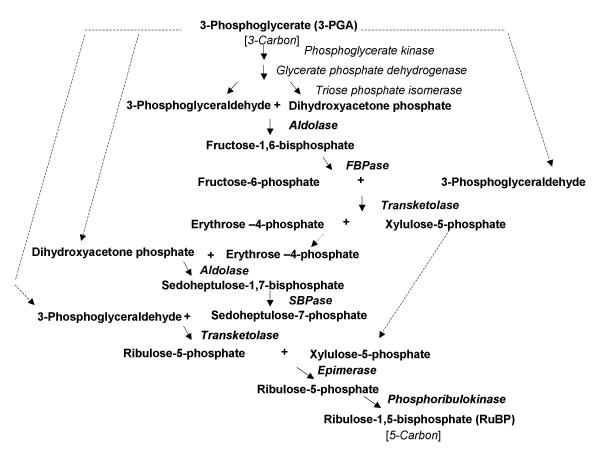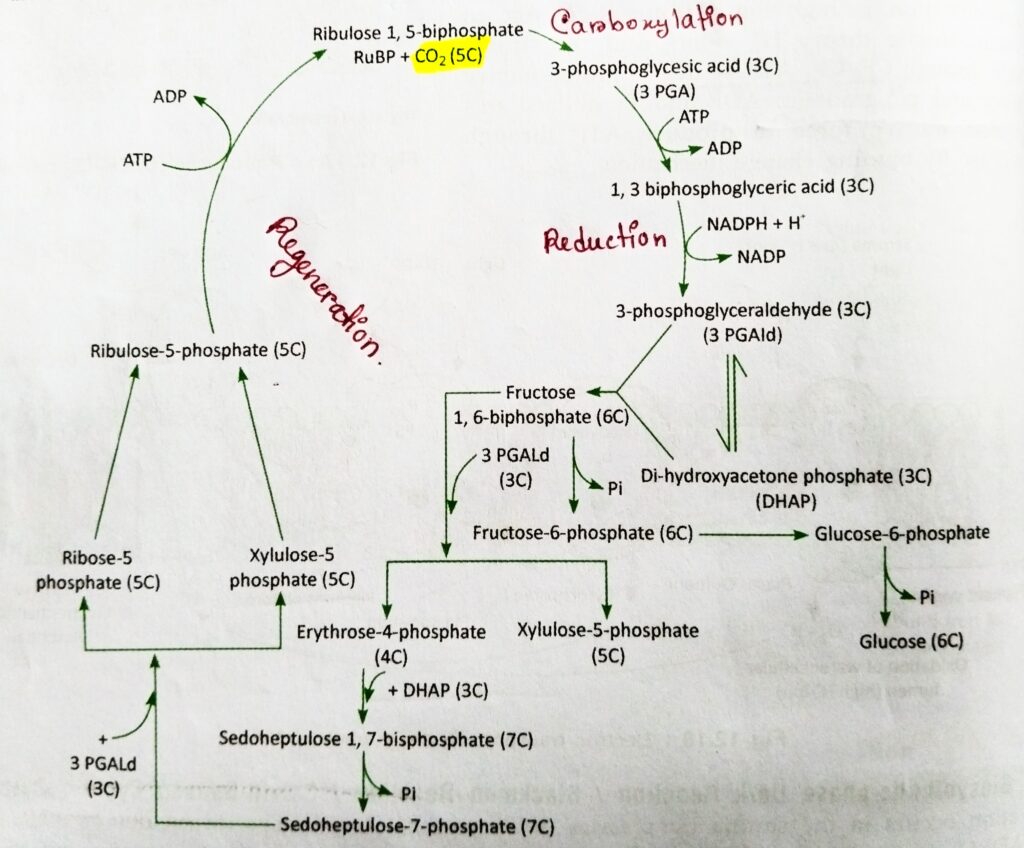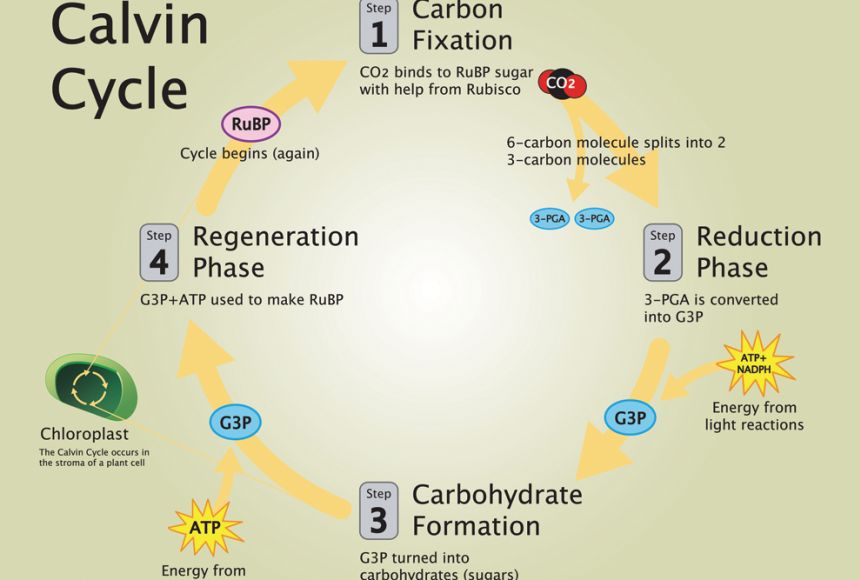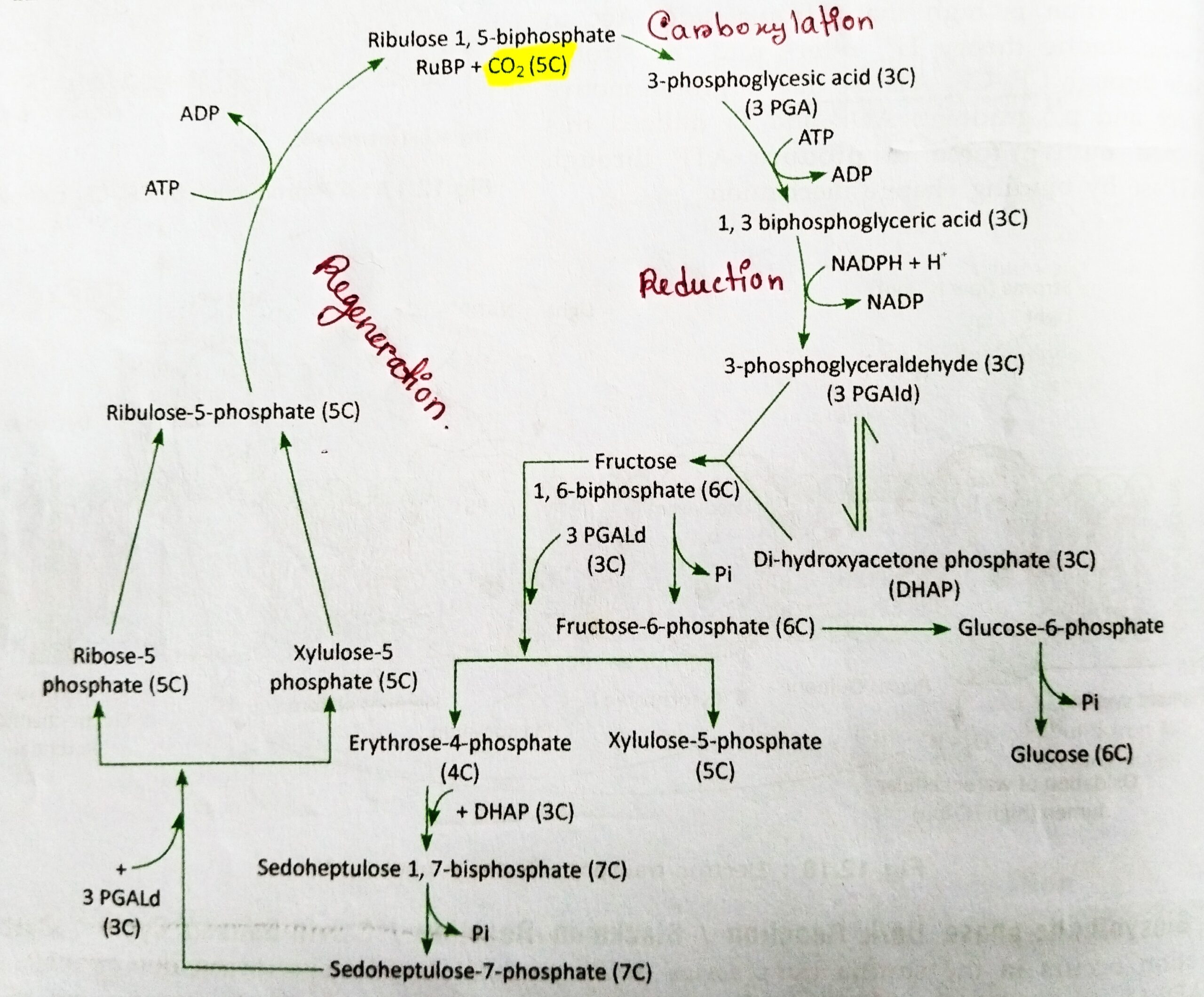Table of Contents
The Calvin Benson cycle has various steps: 1) Fixation of CO2/ Carboxylation, 2) Reduction of PGA, 3) Synthesis of Glucose, and 4) Regeneration of RuBP. Carbon fixation occurs in the stroma by a series of enzyme-catalyzed reactions. Molecules of ATP and NADPH2 produced in light reactions provide the energy required to fix CO2 and to form the carbohydrates. The path of the Calvin Benson cycle were observed by Calvin, Benson and co-workers in Chlorella using 14CO2. They were awarded Nobel Prize in 1961 for this invention.
The first step of Calvin Benson Cycle: Fixation of CO2/ Carboxylation:
In the first phase, CO2 is accepted by a 5-carbon compound, ribulose1, 5 biphosphates (RuBP) to form a labile 6-carbon intermediate (Diphospho-orbitol). This 6-carbon intermediate soon splits up in the presence of water into two molecules of the 3-carbon compound- Phosphoglyceric acid (PGA).
PGA is the first stable product of this pathway; hence, it is called the C3 pathway. This reaction is catalyzed by an enzyme, known as ribulose bisphosphate carboxylase (RuBisCO).
6RuBP + 6CO2 —–RuBP Carboxylase———-> Diphospho-orbitol —–+6H2O———> 2PGA
The second step of C3 Cycle: Reduction of PGA:
PGA is immediately phosphorylated by taking phosphates from ATP produced during light reaction to diphosphoglyceric acid (DPGA). The DPGA is reduced to phosphoglyceraldehyde (PGAld) by taking H2 from NADPH2 produced in a photochemical reaction.
12 PGA + 12 ATP ———-Phosphoglycerokinase———–> 12 DPGA
12 DPGA + 12 NADPH2 ———Triosephosphatedehydrogenase———> 12 PGAld + 12 NADP + H3PO4
The third step of the C3 Cycle is the synthesis of glucose:
In this step, 2 molecules of PGAld form one molecule of dihydroxy acetone phosphate (DHAP) by isomeric change.
a) PGAld ———–Phosphotrioseisomerase—————> DHAP
Then one molecule of PGAld (phosphoglyceraldehyde) and one molecule of DHAP reunite to generate one molecule of the 6-carbon compound fructose biphosphate (FBP). Fructose biphosphate by dephosphorylation produces fructose monophosphate (FMP).
b) PGAld + DHAP ——–Aldolase——–> FBP (Fructose biphosphate)
c) FBP + H2O ——–dephosphorylation————–> FMP (fructose monophosphate) + H3PO4
FMP by isomeric change is converted to glucose monophosphate (GMP).
d) FMP———–Isomerase——————–> GMP
GMP by dephosphorylation is converted to glucose.
e) GMP ————–+H2O Phosphatase——————> Glucose + H3PO4
The fourth step of this Cycle: Regeneration of RuBP:
For the continuous functioning of the Calvin Benson cycle, there must be a regular supply of ATP, NADPH2, and also a sufficient amount of RuBP, which is the primary acceptor of carbon dioxide. For this purpose some of the PGA that is formed (2 molecules) are converted to sugar and balance (10 molecules) is utilized to regenerate RuBP.
The whole process takes place in a cyclic way and the cycle is known as the Calvin Benson cycle or Calvin-Bassham cycle. In this reaction sequence of the cycle several phosphorylated intermediate compounds (C3, C4, C5, C6, C7) are formed which ultimately give rise to a 5-C compound ribulose monophosphate (RuMP). This RuMP (ribulose monophosphate) taking inorganic phosphate from ATP is converted into the acceptor substance RuBP.
a) 10 PGAld —–(C3, C4, C5, C6, C7) [intermediate compound]———> 6 RuMP (Ribulose monophosphate)
b) 6 RuMP (Ribulose monophosphate) + 6 ATP —-Phosphoribulokinase—> 6 RuBP (Ribulose bisphosphate ) + 6 ADP
Schematic representation of the process of the regeneration of RuBP:

Schematic representation of C3 cycle:


Other related notes:
- Photosynthesis equation explanation: https://thebiologyislove.com/photosynthesis-equation-and-reactants/
- Light reaction: https://thebiologyislove.com/light-reaction-of-photosynthesis/
Facebook link: https://www.facebook.com/share/p/ah6UcWFZc7gLLNQe/?mibextid=oFDknk

